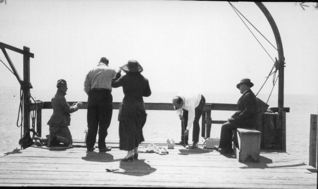 (Photo: The pier at Princeton-by-the-Sea)
(Photo: The pier at Princeton-by-the-Sea)
When the San Mateo County Coastside was identified as a major depot of smuggled Canadian whiskey during Prohibition., pioneer liquor buccaneers Paul Rubio Pane and Thomas Murphy called themselves exporters—but they were hardened professional bootleggers who needed the cooperation of locals to unload hundreds of cases of illegal booze on isolated Half Moon Bay and Pescadero beaches.
Destined for thirsty customers in San Francisco, the whiskey earned Pane, Murphy and their rum-running masters huge profits.
By 1924 Paul Pane and Thomas Murphy had been using South Coast farmer J.F. Steele’s Ano Nuevo seaside ranch as their home base for more than a year. They often ate breakfast at Steele’s place south of the Pigeon Point lighthouse and might have passed as locals. But they took their orders from the notorious Joe Parente. Headquartered in Vancouver, British Columbia, Parente was the king of all the Pacific Coast rumrunners.
After convincing Steele to collaborate with them, Pane and Murphy established a routine. Electricity had not yet reached the Pescadero on the South Coast—and in the evening the road was eerily dark.
Pane and Murphy supervised the nighttime loading of 100 proof-plus Canadian Club whiskey onto trucks—liquor delivered secretly to a secluded beach cove by two small skiffs.
The operation went smoothly until the spring of 1924. As 240 cases of illicit whiskey were being loaded onto trucks, Paul Pane’s sixth sense alerted him to trouble—and trouble usually meant the police. He even felt suspicious of his partner Thomas Murphy, the co-owner of the Prince Albert, a vessel registered in British Colombia.
As usual the Prince Albert’s final port of call was Ensenada, Mexico. Unless witnesses to a crime, the Coast Guard did not board vessels headed for ports outside of the United States. Packed with a full load of whiskey, the Prince Albert sailed south from Vancouver along the Pacific Coast, carefully observing the 3-mile limit near Steele’s Ano Nuevo ranch.
From his position on the beach, Paul Pane, using his secret code-book, signaled the Prince Albert with a flashlight, advising the vessel that it was all clear. A high-powered motorboat rendezvoused with the Prince Albert, taking on board the cases of liquor. From the motorboat, the cargo was transferred again to small skiffs that sailed through the surf and onto the cliff-lined beach. With the loud pounding of waves drowning out conversation, Pane stowed his flashlight, automatically slipping the secret code-book into his coat pocket.
—To be continued–
